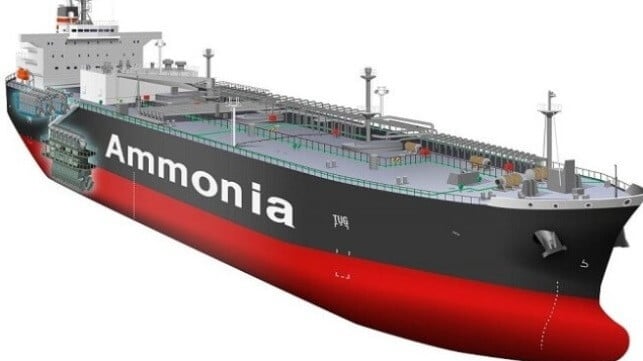Japanese Group Overcomes Challenges of Ammonia to Receive Design AiP

A consortium of Japanese companies working on a project supported by the government reports it has made significant progress in the development of the world’s first ammonia-fueled ammonia gas carrier. The companies are working to develop a design that used the ammonia carried as cargo also as fuel. They are confident that they are overcoming the hurdles required for the first commercial ammonia vessel. They expect to demonstrate the operation of the vessel in 2026.
The group which consists of NYK Line, Japan Engine Corporation, IHI Power Systems Co., and Nihon Shipyard Co., highlights that at present there are no international regulations for the use of ammonia as a marine fuel. Therefore, the consortium has been conducting research and development to ensure that the ammonia gas carrier has the same safety features as vessels using existing fuel oil or LNG fuel.
After developing the design concepts and addressing issues related to safety, they have now conducted a risk assessment of the safety of using ammonia as a marine fuel. As a result of their efforts, they received an AiP from the Japanese class society ClassNK. The companies noted that this is the first time that a risk assessment has been conducted and an AiP obtained not only for a concept but also for an alternative design.
While ammonia is widely regarded as a solution to the shipping industry’s goals for decarbonization of its operations, the consortium points to the challenges that also exist with the use of ammonia.
While ammonia does not emit carbon dioxide (CO2) when combusted, they highlighted the issues with the combustion of ammonia as it is hardly flammable and has low energy density. They have been researching increasing mixed combustion while also creating stable operations for the engine.
Combustion of ammonia however does generate nitrous oxide (N2O) which scientists point out has about 300 times the warming potential of CO2. The combustion design needs to suppress the generation of nitrous oxide. In addition, because of the highly toxic nature of ammonia, the design needs to prevent leaks and have adequate safety measures in the event of a leak.
They are focusing on the design of a medium-sized gas carrier with an ammonia loading capacity of approximately 38,000 cubic meters, which they note is currently the common size for marine transportation of ammonia.
The initiative to develop vessels equipped with a domestically produced ammonia-fueled engine was initiated in October 2021 as part of the Green Innovation Fund Project from the New Energy and Industrial Technology Development Organization (NEDO). The project is developing both a two-stroke ammonia-fueled engine for vessel propulsion and a four-stroke ammonia-fueled engine for onboard power supply.
They are working on a safe and environmentally friendly hull design and together are studying the feasibility of the construction and commercial operation of the prototype vessel. They have completed the concept design of a prototype vessel that addresses safe and the practical installation of ammonia-fuel-related equipment in the limited space available in the vessel. The equipment layout has been devised, and they have developed and selected main and auxiliary engines and onboard equipment while securing an ammonia-loading capacity that is equivalent to or greater than that of conventional vessels. They continue to work on further design optimization.
